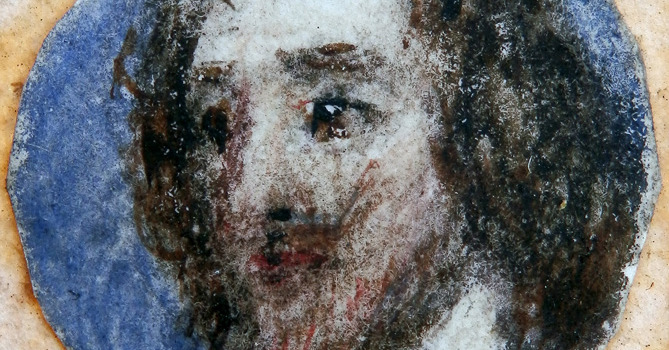
Until recently, death by execution seemed to be a horror from the past. I had never stopped to consider what someone might be thinking or feeling knowing that their life was about to end with a swing of an axe or a sword. But the graphic images of execution from Iraq that have been splashed across our news in recent month are too horrifying to ignore. Although I am a bit of a murder mystery buff I do like to keep the gruesomeness of death definitely in the realms of fantasy. There my mind can cope with the barbarism often demonstrated by humankind.
This made me think about a small miniature that we have in the Abbey Museum collection of Charles I. You might remember that he was executed on Tuesday 30th , January1649. I read that it was a very cold day, but despite this Charles was allowed to take his pet dog for one last walk in St James’ park. It is reputed that he had a last meal of bread and wine. I find it hard to imagine that one could even consider food at such a time. Maybe he was only offered a last meal because his execution was delayed as the man who was supposed to do the deed refused and another execution had to be found.
The miniature painting of Charles I in our collection is believed to have come from the time of his demise. Maybe drawn by an artist in the crowd who watched as this king of England walked to his death? It is said that he asked to wear thick underclothes so that he would not shiver in the cold and that shivering be seen by the gathered crowd as fear.
We know a lot about the man in the miniature, the king executed by his people, but almost nothing about the artist who captured a moment in his life. Hopefully, this is about to change. Recent correspondence with the Keeper of the Royal Collections (who have one of the largest collection of miniatures in the world) resulted in an agreement to assist us. They have requested that we start with an analysis of the paint used in our tiny illustration and we are very happy to announce that the Queensland Art Gallery has agreed to undertake this analysis for us.
Propaganda, aftermath of Execution
The big question is, “who was the artist”? And did he actually witness the death of Charles I? Sadly, initial indication are that the miniature is most likely a later date than the time of Charles I. Interestingly though, it was found hidden between two pages of a rare book, Eikon Basilike – the Sufferings and Solitudes of His Sacred Majestie –, written as a highly successful propaganda document. The book transformed Charles from a stubborn Stuart monarch into a saviour who died for his people.
Hopefully, all will be revealed. So stay tuned.

